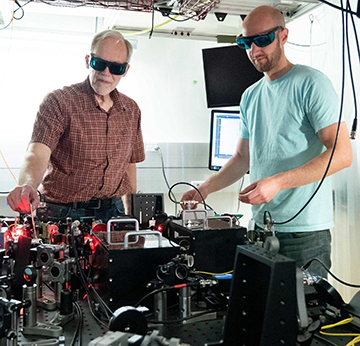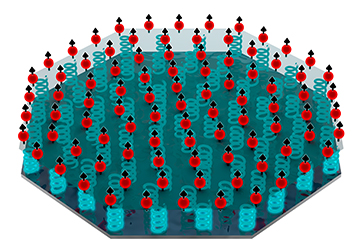
Physicists John Bollinger (left) and Matt Affolter at the U.S. National Institute of Science and Technology (NIST) were among the authors of a study that used a laser-probed 2D array of trapped beryllium ions for ultrasensitive electric-field measurements. The technique could, according to the researchers, aid in the search for the universe’s elusive dark matter. [R. Jacobson/NIST]
Quantum sensors exploiting the strange properties of entangled particles can in principle outperform classical devices. To date, however, scientists have struggled to demonstrate how entanglement can render a “quantum advantage” for useful applications.
Now researchers in the United States have shown how a “crystal” of trapped ions can measure displacements and electric fields at sensitivities an order of magnitude beyond the classical limit. They say the technology is well suited to making measurements of putative dark matter that interacts with normal matter via weak electromagnetic fields (Science, doi: 10.1126/science.abi5226).
Entangling a mechanical oscillator
Entanglement involves an interdependence between quantum particles, such that determining the state of one instantly fixes the state of the other (or others), no matter how far apart they are. The phenomenon could potentially enable all sorts of novel sensors, from quantum radar to so-called ghost imaging. Indeed, scientists have already exploited entanglement to improve the sensitivity of gravitational-wave detectors by reducing phase noise in interferometric detectors.
The latest work instead relies on entanglement to enhance the sensitivity of a quantum-based mechanical oscillator. Such a device registers a small coherent change in its amplitude over time when subject to a weak resonant force. The idea is to entangle the oscillator’s displacement with a measurable property of the system before the force is applied, pushing precision beyond the limit usually imposed by quantum mechanics.
Ion array
The oscillator in question has been made by John Bollinger of the National Institute of Standards and Technology (NIST) in Boulder, Colorado, and colleagues, and draws on theoretical work carried out by Ana Maria Rey and co-workers at NIST and the JILA research institute, also in Boulder. The device involves a 2D array of about 150 berylium-9 ions held within a magneto-electrical trap. The motion of this ion crystal’s center of mass, which measures about 200 µm across, constitutes the (high-Q) oscillator.

The work relied on a 2D “crystal” of trapped beryllium ions (red dots), which was used to measure tiny displacements and electric fields at sensitivities beyond classical limits. [S. Burrows/JILA]
To measure the oscillations, Bollinger and co-workers used microwaves to place all the ions into the same spin state. Next they coupled the spins to the ions’ collective movement using a pair of laser beams, with the beams detuned so that their beat frequency was about equal to the center-of-mass resonant frequency. With entanglement established, they then set the oscillator in motion by applying an alternating voltage at the resonant frequency to one of the trap electrodes.
The researchers found that they could measure the oscillator’s displacement very precisely by reversing the entanglement process in time. Employing the same microwave and laser frequencies they used to do the entangling, they were able to read out the displacement by measuring the spin state (which they did using fluorescence).
Dark-matter detector?
When it came to the displacement itself, Bollinger and colleagues achieved a sensitivity nearly 9 dB below the standard quantum limit. Measurement of the electric field, meanwhile, yielded a 4-dB improvement over classically limited measurements. This latter figure translates to a sensitivity of 240 nanovolts (nV) per meter per second.
The researchers say that their new scheme could be used to detect some forms of dark matter—the mysterious substance thought to make up some 80% of matter in the universe. The idea would be to measure the oscillations induced by the very weak electromagnetic interactions of what are known as axions or hidden photons.
They point out that the system’s sensitivity to axions is limited, because the small spatial size of its magnetic field suppresses the electric field that axions can generate. Nevertheless, they estimate that with an improved electrical sensitivity of 10 nV/m/s, they could reach down to the current best limits on axion–photon coupling after taking data for just one day. This sensitivity, they suggest, could be obtained relatively easily by improving the stability of the oscillator’s resonant frequency as well as reducing thermal noise.
Beyond these improvements, the researchers envision additional improvements, such as using 3D crystals to house around a million ions, or boosting the size and strength of the trap’s magnetic field. These steps, they argue, could further improve the sensitivity for detecting dark matter, by “as much as three orders of magnitude.”
